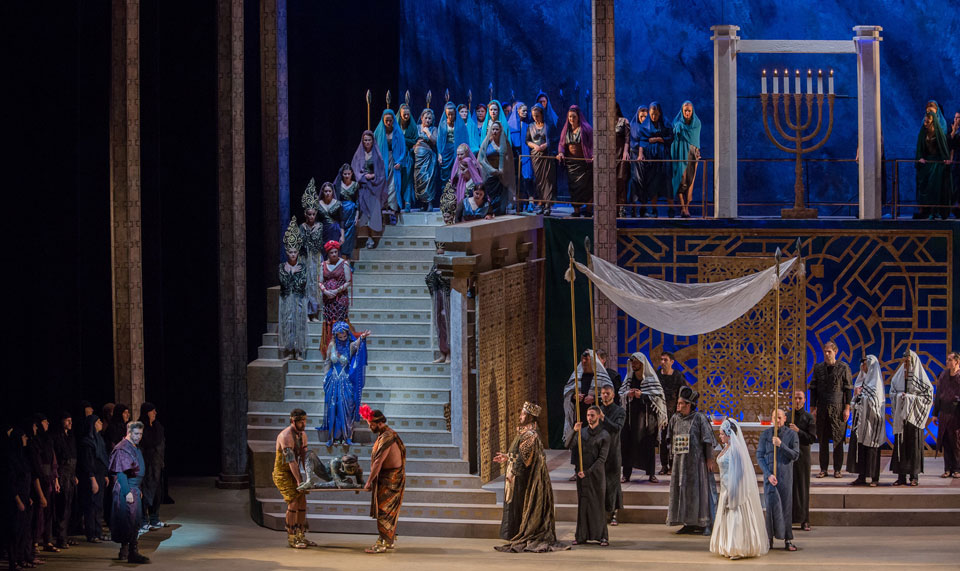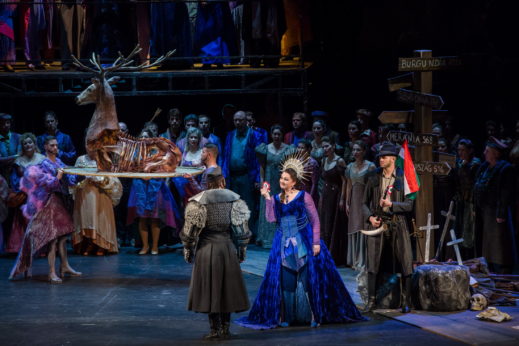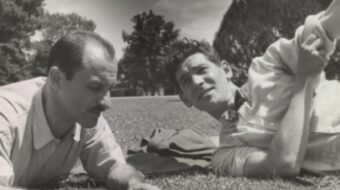
NEW YORK—For three nights, Nov. 1-3, the Hungarian State Opera ruled the David H. Koch Theater at Lincoln Center with a roster of all-Hungarian operas. The first night included the double-bill productions of Béla Bártok’s Bluebeard’s Castle and János Vajda’s Mario and the Magician, already reviewed in People’s World.
On the two successive nights New York audiences were treated to a pair of genuine rarities in the American opera house: Karl Goldmark’s The Queen of Sheba (Die Königin von Saba), which premiered in 1875 and soon made its way around the operatic world. New York’s Metropolitan Opera introduced it in 1885 and staged it for a number of seasons, the last in 1906. On Nov. 3, the last night of the Hungarians’ opera “season” (followed by a week of dance performances by the Hungarian National Ballet), we saw the U.S. premiere of a signature work of Hungarian nationalism, Ferenc Erkel’s 1861 Bánk Bán (The Viceroy Bánk).
The very fine 1999 film Sunshine recounts five generations of Hungarian Jews, from the days of the Austro-Hungarian Empire, through the brief communist revolution after WWI, the subsequent pro-fascist monarchy of 1920-46 during the so-called “Regency,” complete with Nazi occupation beginning in 1944, then the communists in power, the 1956 revolution, and the end of socialism in 1990. I recall thinking at the time, when the “shock doctrine” of capitalism was being applied, lowering living standards and the longevity rate, that at some point a new chapter would need to be added to the story: how the Jews fared under capitalist neoliberalism.
Some 100,000 Jews live in Hungary today, most of them in Budapest, the capital. It is a prosperous community. But as I feared, anti-Semitism has reared its head once again.
Immediately as soon as the communist reins were withdrawn, anti-Semitic organizations and media started running amok, accusing the Jews of every sin Jews have always been accused of—being Bolsheviks, being cosmopolitans, being in the pocket of master globalist schemer George Soros (Hungarian by birth), killing the Christ, etc.
Extremist organizations have flourished, such as the emergence of Jobbik and other movements and parties. The far-right has resurged and infected the nation’s culture and media. What had been quietly muttered is now publicly brandished. Anti-Semitic—and anti-Roma and anti-immigrant—violence has heightened. Now Prime Minister Viktor Orbán is leading Hungary in what many political analysts call an authoritarian soft fascist direction.
When The Queen of Sheba started making the opera circuit, London’s Covent Garden passed on it, for British law prohibited Biblical stories from being staged in the UK. This accounts for the enormous flowering of oratorios from Handel’s time onward, Biblical stories told in concert form. It played at the Vienna Opera almost every season until the Anschluss year of 1938.
Karl Goldmark (1830-1915) was born in the town of Keszthely, the son of a Hungarian synagogue cantor. Given his family background he surely had a Jewish education and knew his Bible stories. He spoke German as his first language, and we may presume knew at least prayerbook Hebrew, but could not speak Hungarian. As he matured musically he transferred to Vienna and wrote all his operas to German librettos, although he did write some orchestral music on Hungarian themes. The libretto to The Queen of Sheba is by the Jewish writer Salomon Hermann Mosenthal.
Hungary can legitimately claim Goldmark as a native son. It seems to be no oversight, however, that the three-paragraph biography printed in the program fails to mention that he was Jewish. Yet his background informs The Queen of Sheba profoundly, and not just in the choice of subject. Some of the liturgical music Goldmark wrote for the synagogue scenes recalls the great Jewish choral works of Louis Lewandowski and Felix Mendelssohn. Stylistically, Korngold was influenced by Verdi, Wagner and the grand operas of Giacomo Meyerbeer (who was also Jewish). The Queen of Sheba sounds like a mashup between the sensual French operas Lakmé (Delibes), Samson and Delilah (Saint-Saëns) or Thaïs (Massenet), and an early Biblical opera by Verdi.
The historical existence of such a queen—who never seems to have acquired an actual name—is speculative. She is mentioned in I Kings in the Bible as having visited Solomon, and there is rumor that when she returned home she took with her the son he fathered. Sheba (or Saba, which is closer to the ancient sources) was a kingdom in what is now Yemen, or perhaps in Egypt and/or Ethiopia. Occasionally in her representation in art, film and opera (there are several other Queen of Sheba operas besides this one) she is a woman of color, which would make sense—Halle Berry played her in one film avatar—but in the Goldmark Hungarian version she is an alluring blonde, the highest 19th-century European expression of beauty.
The plot revolves around a love triangle. On the eve of his marriage to Sulamith (Eszter Sümegi), daughter of the high priest, Assad (Boldizsár László) has been assigned by King Solomon (Zoltán Kelemen) the duty of going out to prepare the way for the Queen of Sheba’s (Erika Gál) arrival at Solomon’s court. The Queen, a pagan, will be so impressed by Solomon, he says, that she will bow to the Lord. But Assad met a mysterious woman amongst a vale of cedars of Lebanon the night before the impending marriage and admits to Solomon that he became enchanted by her and cannot marry Sulamith. When the Queen appears, Assad recognizes her as the woman he fell in love with. The Queen, however, fails to recognize him.
In a garden of the palace that night, the Queen’s handmaiden Astaroth (Eszter Zavaros) sings a magically wondrous “Oriental” song, knowing that Assad is nearby and will be lured closer to meet the Queen. Assad approaches and after an argument over her behavior earlier that day, they embrace, discreetly pulling a large cloak over themselves for the night. They are awakened from their blissful encounter only by the Temple Watchman who calls the Jews to morning prayer. A rendition of Assad’s heavenly aria “Magische Töne (Mystical Sounds) from this scene, performed by tenor Nicolai Gedda, can be heard here.)
At the wedding ceremony, complete with the traditional canopy (the khupa), in which Assad participates rather against his will, the Queen appears with her gift of wild animals. But still and again she regards Assad like a stranger, which drives him mad. He bows down to her feet and calls her his god, for which act of blasphemy he is led away, likely to his death.
At a ceremony to honor the Queen, she pleads with Solomon for Assad’s life, but he refuses to pardon him. Sulamith also arrives, sad about being left at the altar, and pledges the rest of her life to serving God, also asking for mercy for Assad. Sulamith retires to the desert to lament her fate.
Solomon has taken pity on Assad and banishes him to the desert. The Queen finds him there and begs him to escape with her. But Assad has repented and now only longs for death. He almost dies in a sandstorm, when Sulamith finds him. She forgives him and then he dies. The current staging seems to have them both dying together.
The opera calls for three very accomplished singers in the triangle, and Budapest certainly sent its best, led by conductor János Kovács. With brilliant costumes by Anikó Németh, and fascinating “Orientalist” choreography by Marianna Venekei, directed by Csaba Káel in a formal, ceremonial style, it was a dream come true to finally experience this opera in all its glory. The sets by Éva Szendrényi, and the costumes as well, did indicate the Jewish setting, so there seemed to be no denial in that department.
The work is known among opera lovers today mostly for Assad’s single high-flying tenor aria “Magische Töne,” but deserves to be known for much more. It may never return to the popular repertoire but it surely merits the occasional showcase. The Hungarian festival took place in the hall where the New York City Opera once staged some of its most adventuresome productions, which I attended regularly when I lived in the city. I actually wondered how come NYCO never got around to reviving this work. Performed with a good cast it would have been well received.
Just one more note on this performance: The originally announced season called for two performances, one on Weds., Oct. 31 and this one on Fri., Nov. 2. Owing to lackluster advance ticket sales, the Oct. 31 performance was canceled, leaving only the Fri. show. Most opera-loving Jews, like myself, are not especially religiously observant; but for others who may have wished to see this historically significant work by a Jewish composer from Hungary and who keep the Sabbath, scheduling it on a Fri. night made attendance impossible. I have no idea if this was a consideration or not, but I thought it unfortunate.
The Viceroy Bán
If Hungary has a single opera that could be called its national epic it would be Bánk Bán. Based on a previously censored play, moderately successful composer Ferenc Erkel (1810-1893) premiered this work in 1861. Although he wrote other operas before and after, this is the one for which he is known, a passionate, emotional work that is taught in Hungarian schools.

The current new production from 2017, directed by Attila Vidnyánszky, with the role of Bánk rewritten for baritone as opposed to the original tenor, is the first in Hungarian in America (a 1984 performance in New York was in English, with reduced orchestra).
Erkel can be considered “the Hungarian Verdi” insofar as he takes on political themes, casting them in personal, often romantic terms. A cauldron of jealousy and patriotism at the Hungarian court, complete with war, murder, rape, betrayal, seduction, and class conflict, it’s not over till the soprano has her extended mad scene and commits suicide in a river.
With its opening notes in the orchestra Erkel announces this is a Hungarian national opera: For the first time in a composed piece of music, the cimbalom, a hammered chordophone in the zither or dulcimer family, is employed in the orchestra.
Set in the early 13th century during the reign of King Endre II (Marcell Bakonyi), who is off at war, the Hungarians have become vagabonds in their own country. Viceroy Bánk (Levente Molnár) is sent out to conquer the nation’s enemies, but at home, Queen Gertrud (Judit Németh) has surrounded herself with a klatch of high-living Meranian courtiers who bring disgrace to Hungary—and to Bánk’s wife Melinda (Zita Szemere). Besotted by the frivolity of the court, Gertrud is oblivious to the distress across the land.
Out in the fields of war, Bánk is approached by a poor elderly peasant who turns out to have once saved Bánk’s life. He is Tiborc (István Rácz) who gains Bánk’s confidence. Melinda appears with their son, and she is on the verge of a serious mental breakdown. At Bánk’s request, Tiborc escorts her and the son back to his castle on the bank of the Tisza River. Bánk sings the aria “Hazám, hazám” (My homeland, my homeland), which has become a second national anthem expressing the yearning for independence and national identity at a time when Hungarians were struggling for them. Molnár received thunderous applause for this emotionally charged number from the many Hungarians in the house. A video of him singing this aria can be viewed here.
Patriotica in the 19th century—flags, anthems, schools, theatre, opera—when Hungarian nationalism was being suppressed, is an appropriate response in accord with the right to national determination which both left and right could agree upon. But does it take on a different coloration as the “defense” of national sovereignty and rights when the country is already established in the community of nations and such an anthem might serve the cause of fencing out refugees, asylum-seekers and immigrants in the name of national homogeneity? And if they are turned away at the borders by nationalist rhetoric and policy, can native Hungarian Roma people and Jews feel safe? This is, I am afraid, what is happening under the Viktor Orbán government today.
Furious with Gertrud and her lascivious brother Ottó, Bánk returns to the court, confronts the queen, who draws a dagger on him, but he overpowers her.
A storm overtakes Tiborc, Melina and the child. She refuses to cross the river to the safety of her castle, and instead, in a mad scene worthy of bel canto masters Bellini or Donizetti, throws herself into the river and drowns with her son. Back at the court, Bánk admits to killing the evil queen, and then the bodies of his wife and son are brought in with Tiborc. Having lost everything, he breaks down and ends his own life.

Geographically, Hungary is a fairly low-lying country. Its mountain ranges rise to only about 3000 feet. Vast plains characterize much of the land, with rolling hills in the rest. Thus, Hungary has been subject to foreign invasion and occupation for centuries. In that respect, it’s a wonder that the unique Hungarian culture and language—unrelated to the Slavic languages that surround it—have survived at all. Politically, Hungary achieved its independence only with the dismemberment of the Vienna-ruled Austro-Hungarian Empire at the end of World War I.
Thus it is not strange that an opera that celebrates this unique and persistent nationhood in the face of multiple foreign threats should have become and remains one of the culture’s crowning artistic achievements. The symbolism of the raped Melinda and the heroic Bánk Bán, the husband who was unable to save her, but who at least resisted the foreigners, has deep national resonance.
Musically there is much here that is admirable. The opera has not traveled well, largely owing to the challenge of the Hungarian language, which only Hungarians know. This is a case where the old European tradition of presenting opera in the vernacular of the country—Italian operas in German, Hungarian operas in English, French, German or Italian, for example—would be indicated. The performers were almost all convincing both dramatically and vocally. Standouts were the roles of Gertrud, Bánk Bán and Tiborc. Unfortunately the Melinda had a night of pitch problems which made her mad scenes far too long. The chorus performed quite well. Balázs Kocsár led the orchestra, as he had the first night for Bluebeard/Mario.










